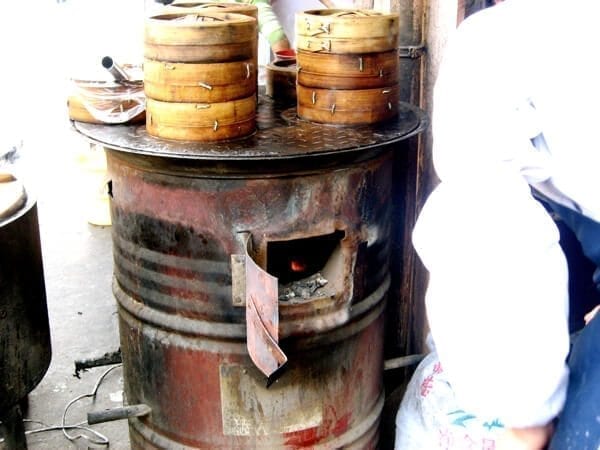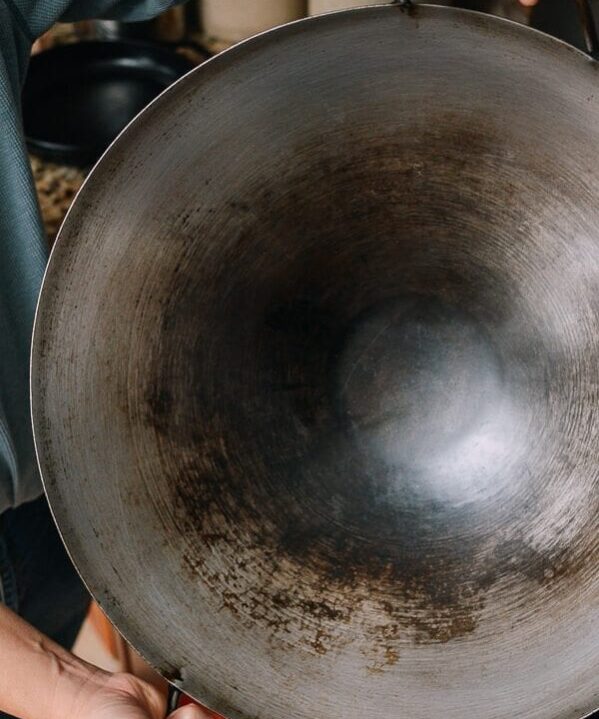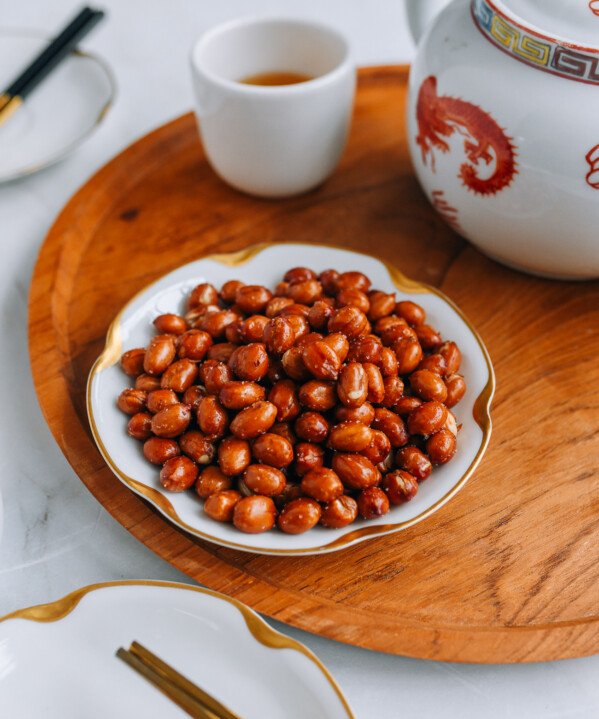If you’ve read our post on choosing a wok, you now know that our personal preference here at The Woks of Life is a classic carbon steel wok. You may have even gone out and purchased one. But it’s also important to know how to season a wok. Most require seasoning before first use and continued maintenance to continue building that nonstick patina.
A Brief Overview
Basic carbon steel wok models typically range from 12 to 16 inches (30 to 40 cm) in diameter and are made with 14- to 16-gauge steel. (14-gauge is about 2mm thick, and 16-gauge is about 1.6mm thick.)
Most basic carbon steel woks made for home use have a long handle on one end and a helper handle on the other so you can use two hands to lift it. Many Chinese grocery stores stock these basic woks, so try shopping locally and check your options online before making your final purchase.
We have a few links and resources on our Chinese cooking tools page and on our post on how to choose the best wok for you.
Below, we’ll walk through the detailed first-time seasoning process that you should apply to every new carbon steel wok.
(That said, friendly reminder to also be mindful of any manufacturer’s directions and warranties you may have!)
Building a Patina
After you go through the initial wok seasoning process, all you need to do is cook with your wok often and follow our easy directions to care for it properly!
Cooking with your carbon steel wok regularly means that the metal will be exposed to lots of oil at high temperatures, and over time, it will continue to season naturally.
I made dinner at a friend’s house once, and I was horrified at his wok. It was downright greasy and covered in crusty layers of old food. His “method” of seasoning was not scrubbing the wok clean after use.
Do. Not. Do this.
Just follow these steps and essential pointers, and your carbon steel wok will age gracefully and form a beautiful patina that any Chinese cook would be proud of.
Let’s do this.
When you are seasoning a wok for the first time
Your carbon steel wok will come with some industrial oils and dust on it from the factory, so it’s always best to give it a quick wash with some mild soapy water. A scrub sponge with a green scouring pad on one side is all you need.
After washing, towel dry your wok and transfer it to your stove. Wrap the helper handle and even the lower portion of the long handle with heavy duty aluminum foil to prevent them from burning. (The photos did not show this because I forgot to do it, but I added some foil halfway through the process.)
***Heavy-duty*** aluminum foil
It’s super important that you use a thick layer of heavy duty aluminum foil if you want to save wooden handles from getting scorched! The heating step takes long enough that too thin a layer of aluminum foil will start to melt. Eventually your wooden handles will get a bit scorched with regular use, but you want that to take years, not happen right off the bat when you’re seasoning it!
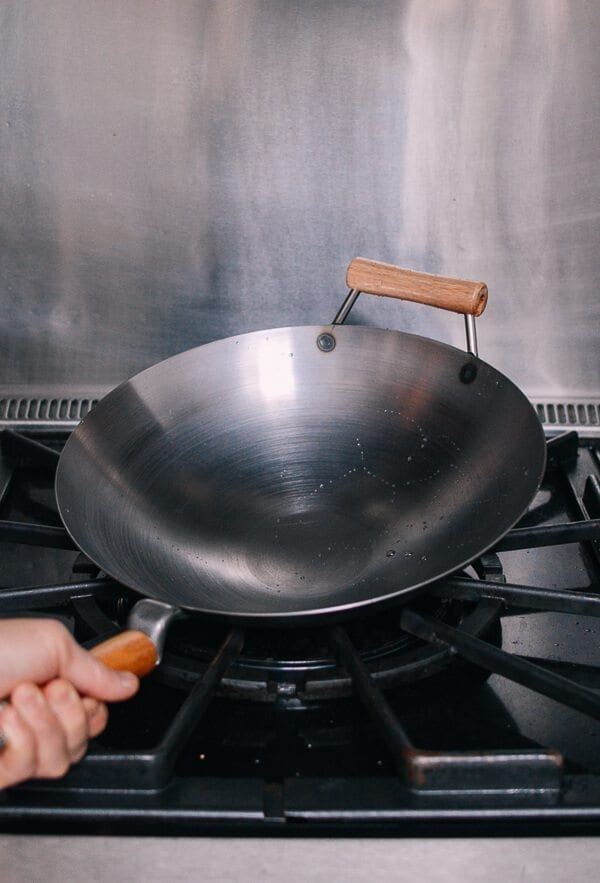
Set your wok over high heat. Make sure you clear the stove area, because things will get quite hot. Keep a dry towel or a heatproof kitchen mitt handy.
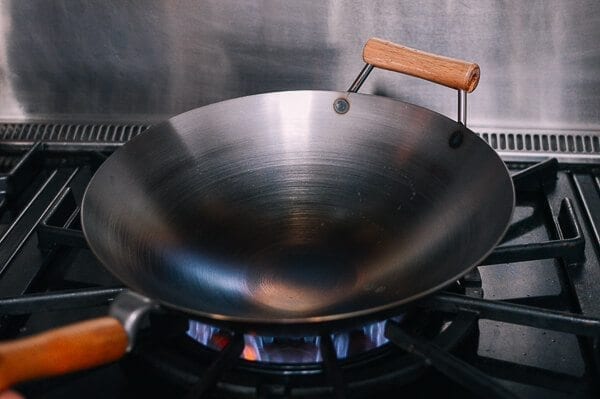
Once the wok heats up, it will start to turn a dark brown color and begin to smoke. This indicates that residual oils are burning off. You cannot see much smoke in the photos, because we have our trusty kitchen hood going at full blast.
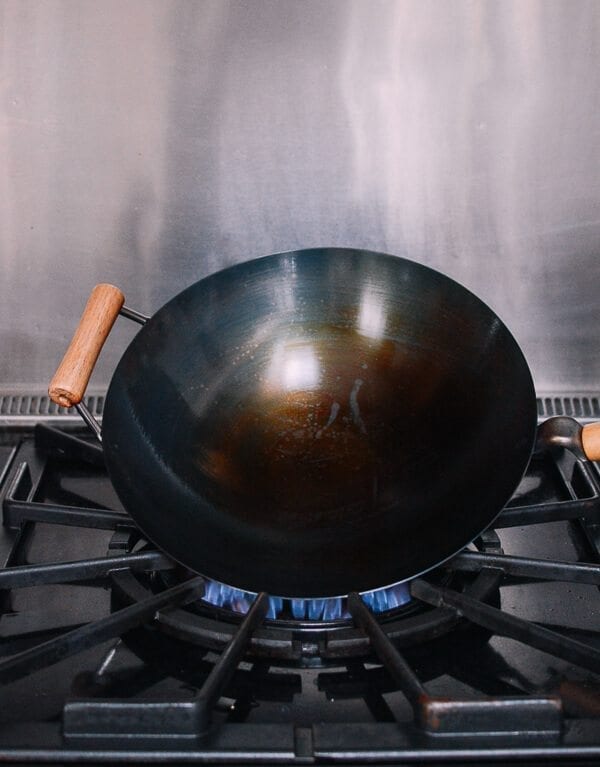
Next, the wok will begin superheating and the impurities from those industrial oils will burn off. Tilt the wok to superheat one area at a time, and you’ll see it turning black and blue as the carbon steel heats through.
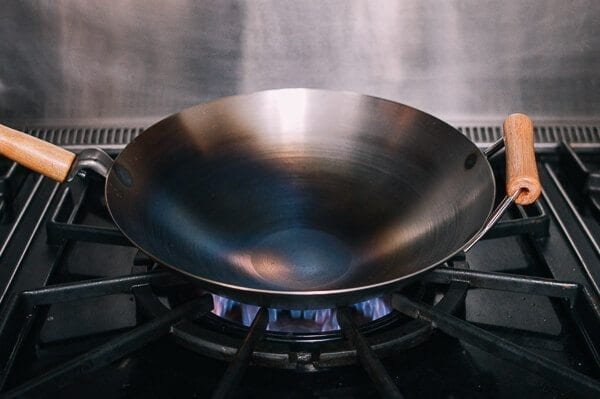
Continue tilting the wok while you systematically heat all areas of the wok. Be diligent at this step to ensure even seasoning.
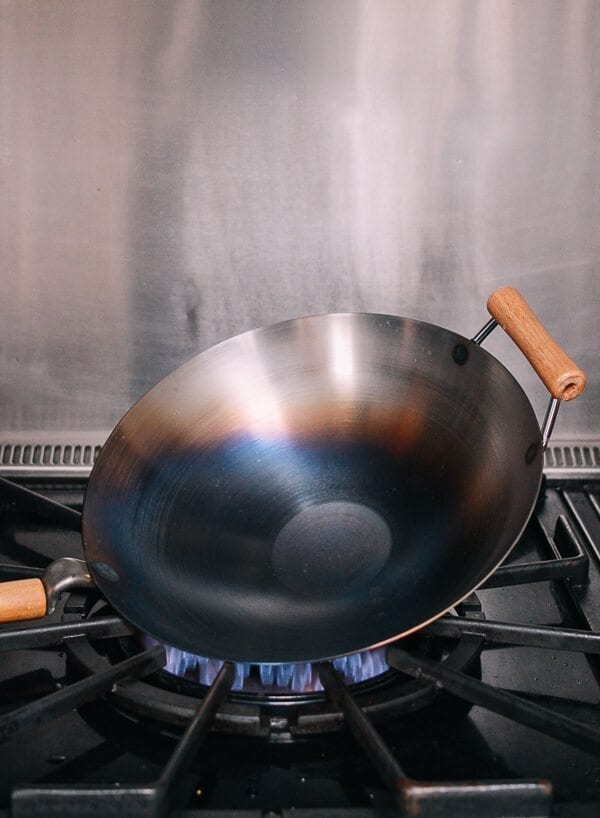
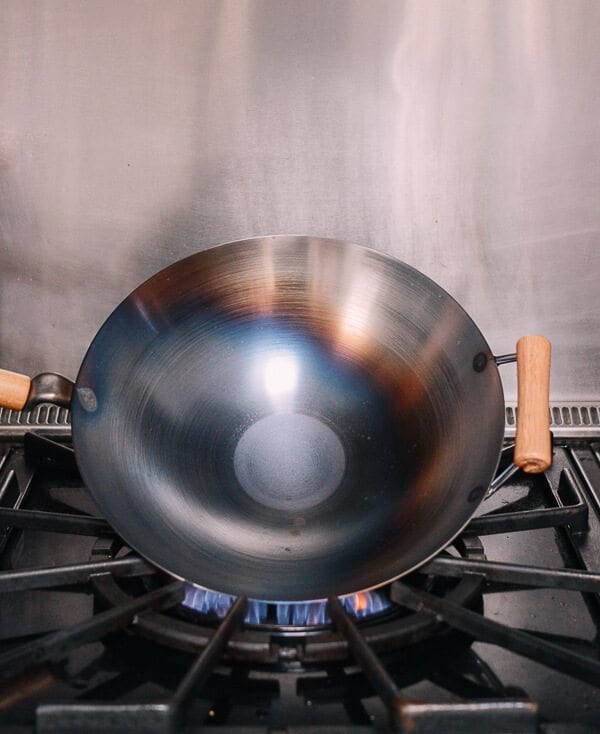
(At this point, I realized I needed to cover the handles with heavy duty foil! I quickly wrapped the handle as best as I could, but you should do this before you start.)
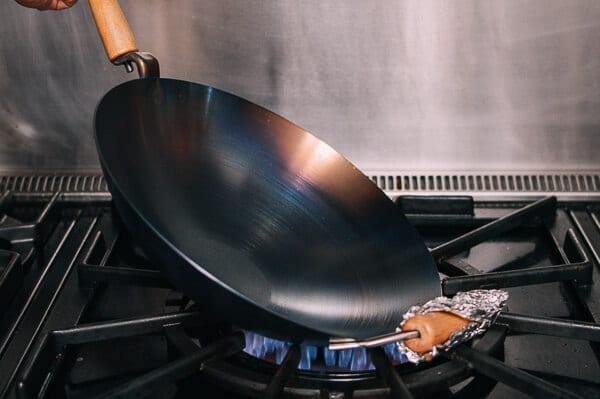
(My wok handles got a bit scorched, but hey it adds character, right?)
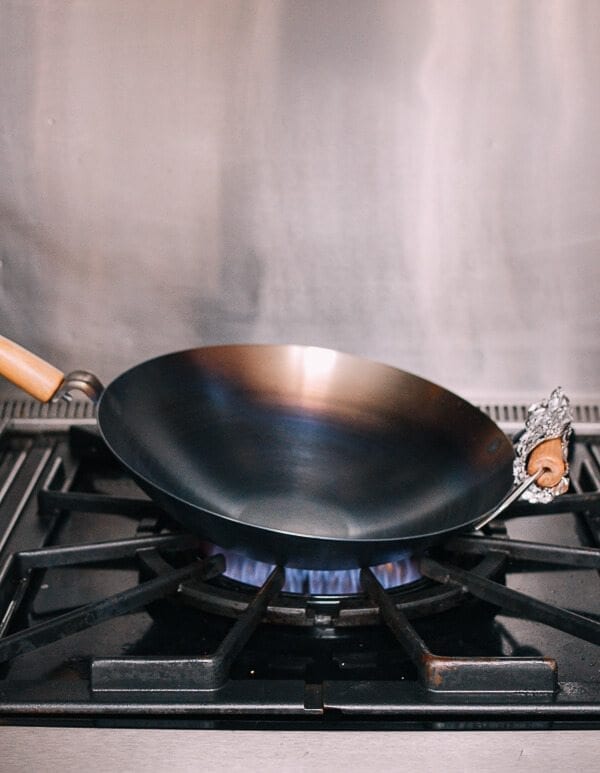
This heating process will take some time, depending on how hot your stove is.
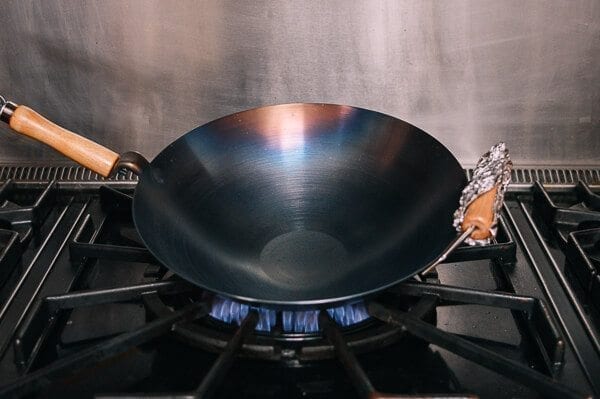
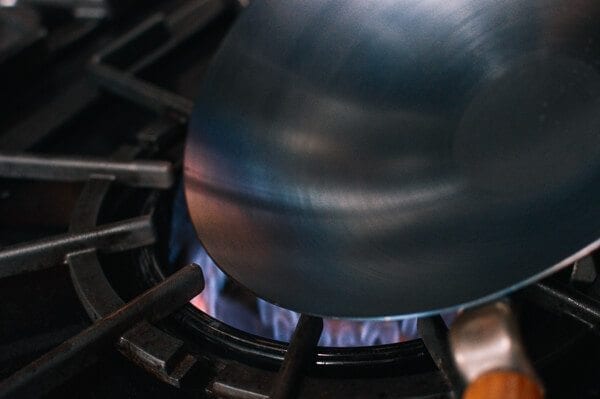
Once your wok has been fully heated, the carbon steel will take on a blue tint.
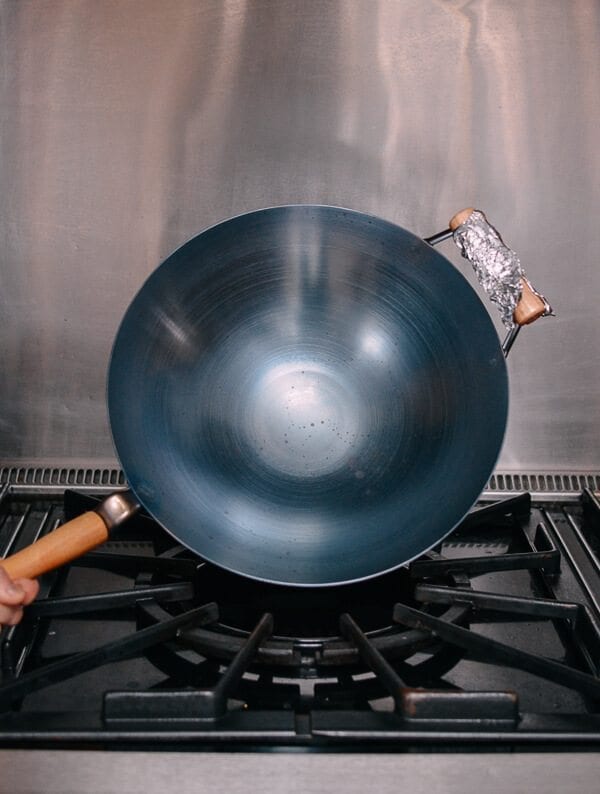
Turn off the burner and set the wok back on the stove to cool for a few minutes. Carefully pour about 1 cup of hot water into the wok to cool it off. Beware of the hot water splashing! Don’t use cold water to cool off the super-heated wok as we have heard reports from some readers that it may warp their wok!
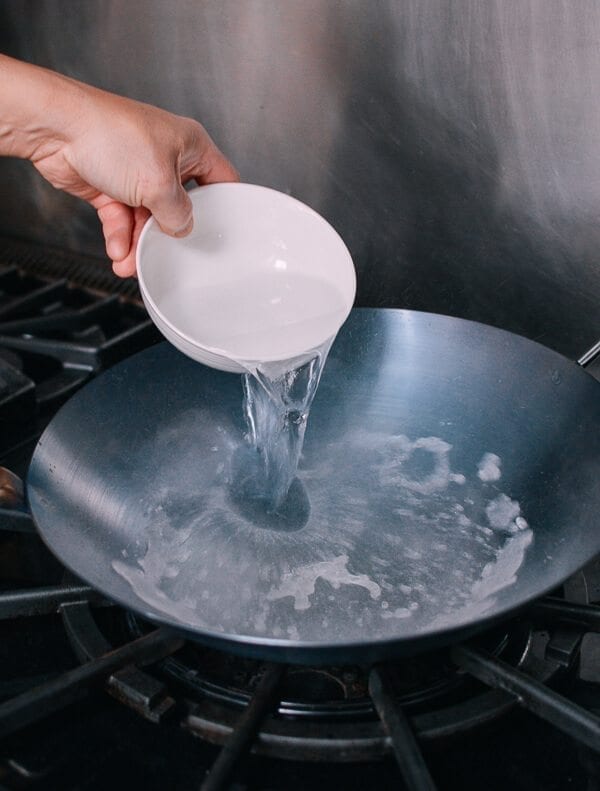
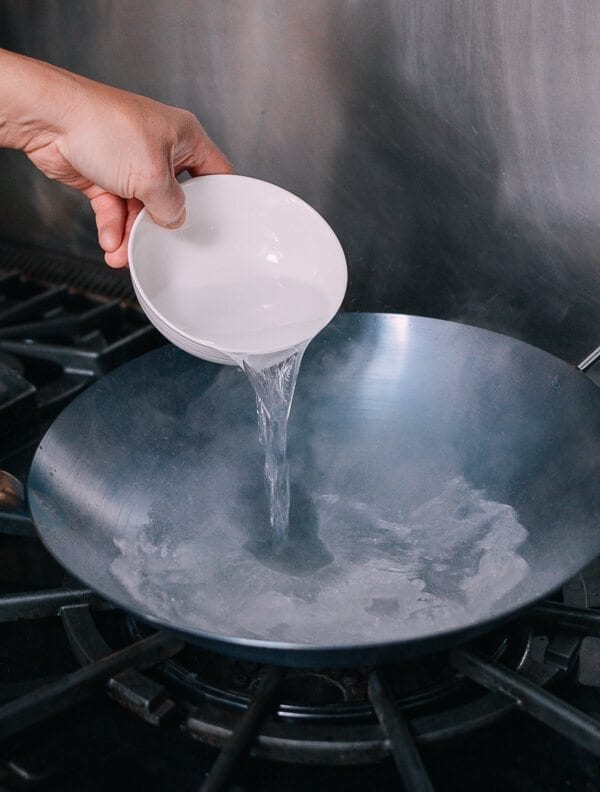
Once cool, move the wok to your sink, and use some mild detergent and your scrubbing pad to give it a light scrub. Rinse thoroughly with clean water.
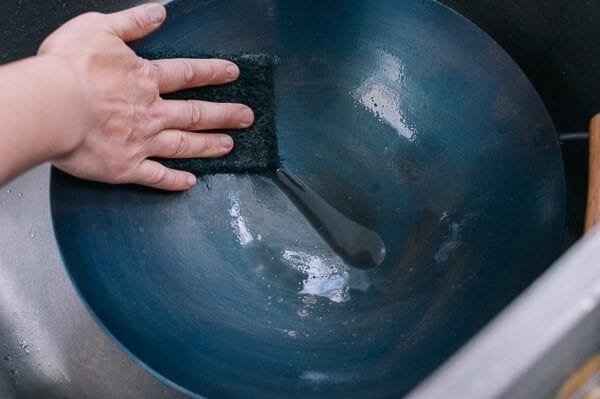
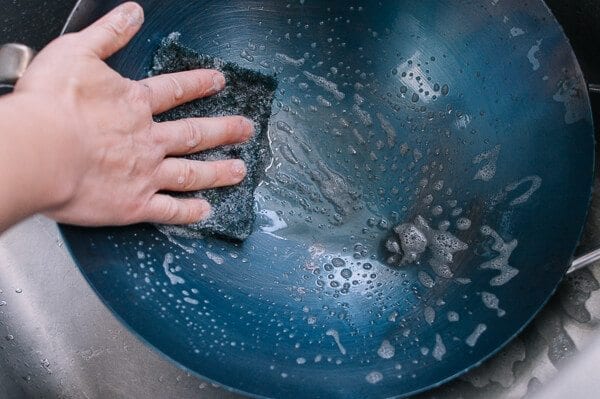
You may see some dark spots in the metal from impurities in the carbon steel, but it’s nothing to worry about.
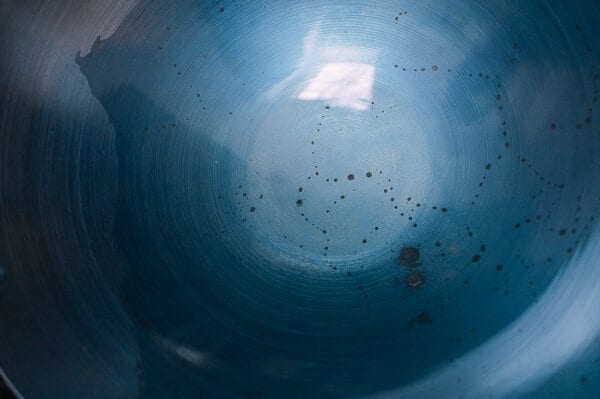
Wipe down the excess water with a paper towel, and place the wok back on the burner to dry it over medium high heat.
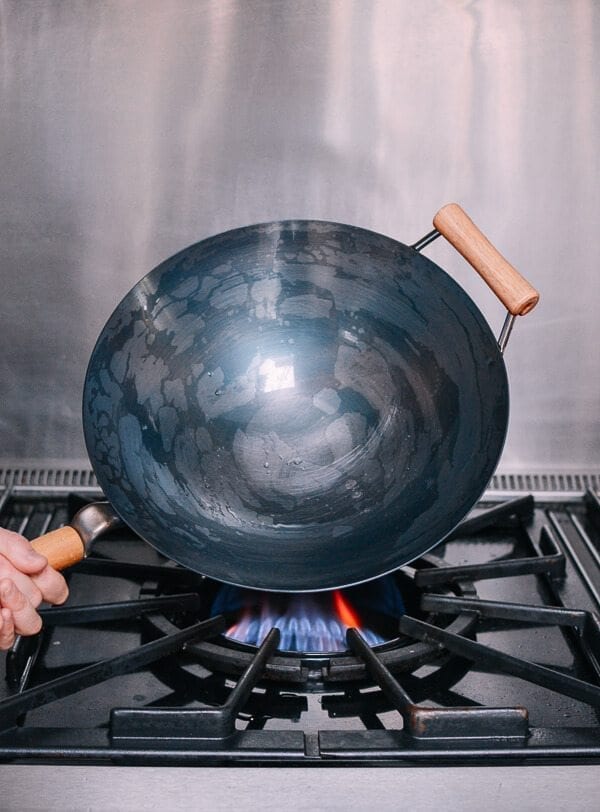

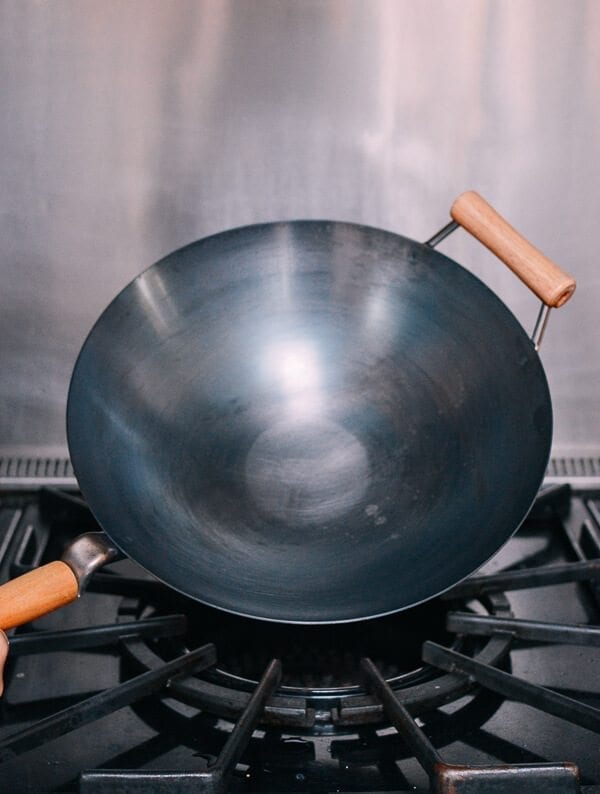
After drying, add about a tablespoon of vegetable oil to the wok over low heat.
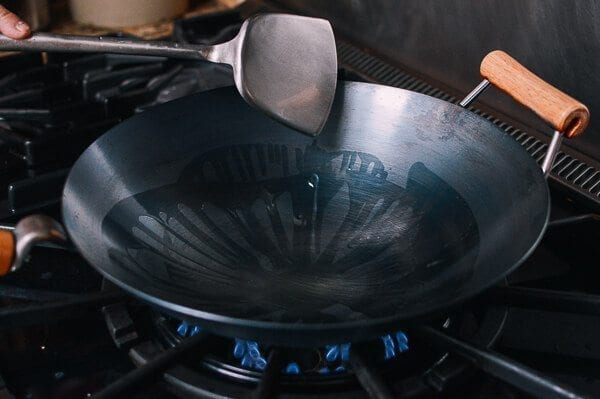
Spread the oil around the wok by tilting it until you get an even coating, and heat for about 1 minute.
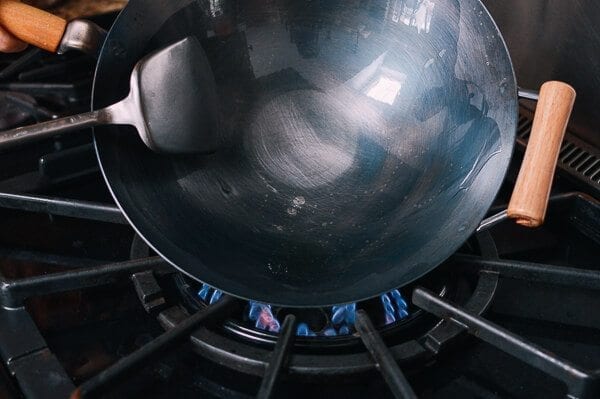
Turn off the heat and use a folded paper towel to begin wiping down the wok. Use your wok spatula to start, since the wok will be hot. After it cools, you can hold the paper towel with your hands to continue wiping it down.
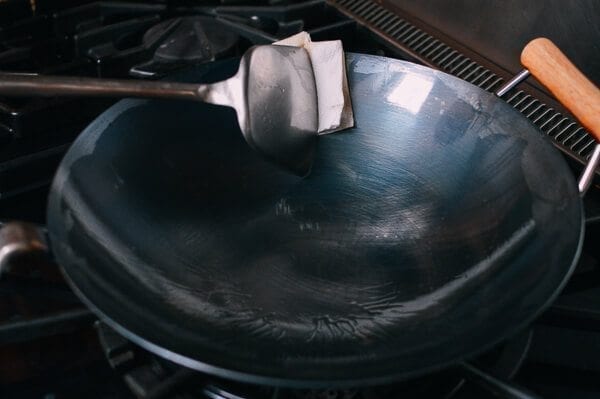
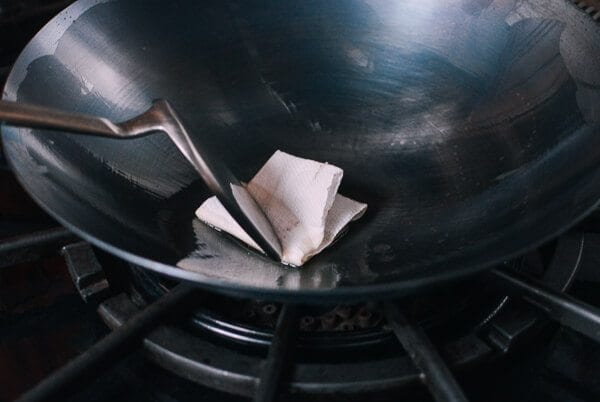
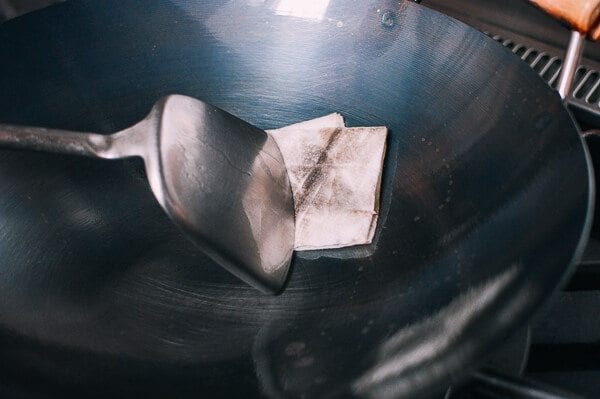
I like to reheat the wok again at this point until just smoking. Then turn off the heat and give your wok another light scrub with water only. You can see that the vegetable oil has begun to form a patina already!
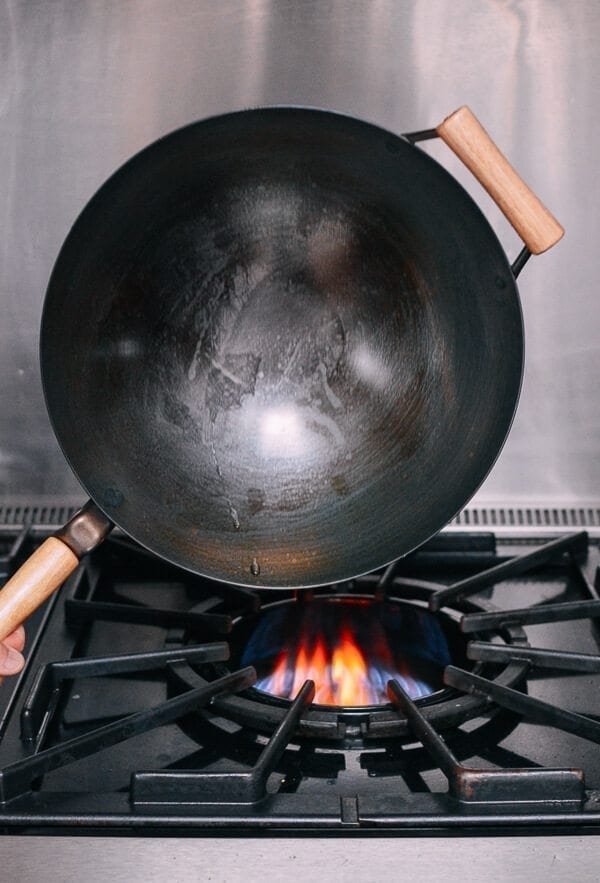
Towel off any remaining water, reheat the wok, and oil it again using a folded paper towel.
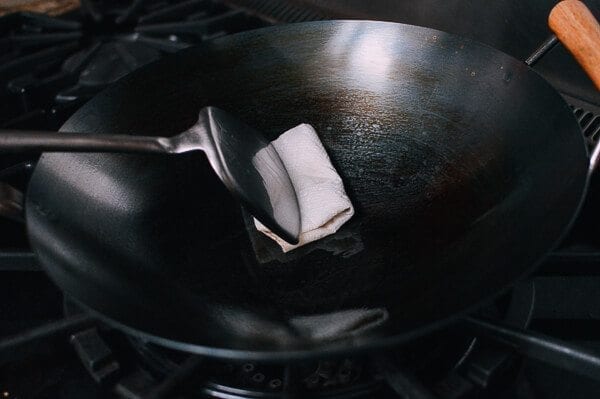
You will be repeating this process every time after you cook. Reheating the wok to remove any trace moisture that you cannot see with the naked eye is very important to prevent rusting.
For now, your new wok is seasoned and ready for your first stir-fry dish!
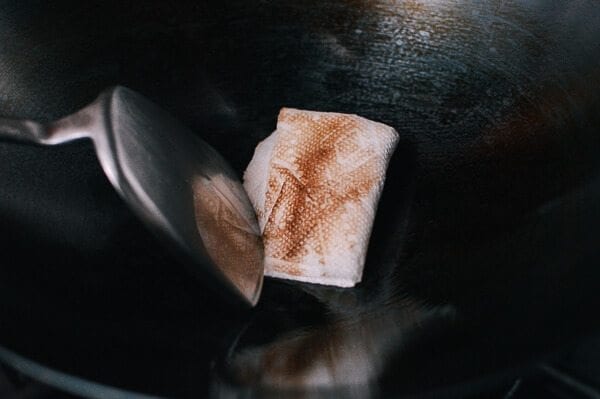
Cook your first dish after Seasoning your wok!
You can start start cooking right away with your seasoned carbon steel wok! We chose to start with a leafy green dish like stir-fried spinach.
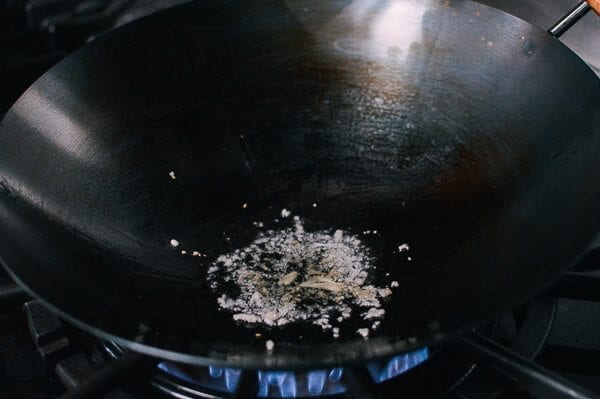
Heat the wok until just smoking. Then add oil, minced garlic, and your spinach or other leafy greens.
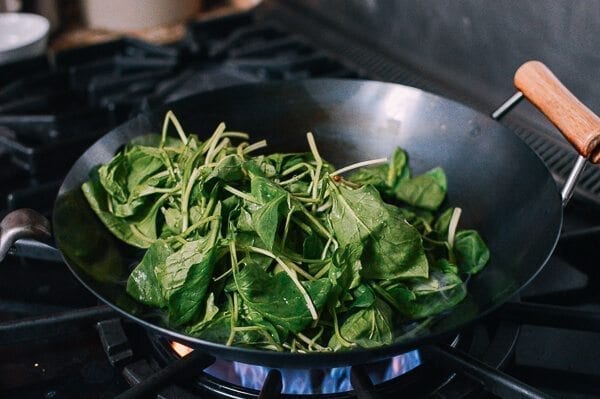
Stir-fry the spinach until just wilted, season with white pepper and salt, and serve!
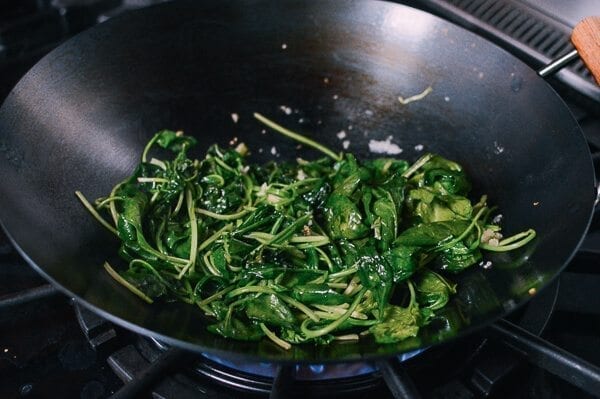
Then follow the same easy steps to care for your seasoned wok over time:
After your wok is cool enough to handle, move it to your kitchen sink, and use your scrubbing pad and some water to lightly scrub and rinse the wok clean. (You can use dish soap, but it’s not required for a light dish like this.)
Towel dry, reheat, and after it is cool enough to touch, wipe the entire wok down with a paper towel and a few drops of vegetable oil. Your wok’s ready for storage until your next dish!
When you haven’t used your wok IN a long time
Did you buy a carbon steel wok years ago and promptly forget about it? We’re here help you dust it off and get it back into the swing of Chinese home cooking.
But after a long time of no use, it may be a little worse for wear. Here’s what you can do to revive it:
- Scrub it thoroughly with a small amount of mild dish detergent and make sure to get the entire surface area as clean as possible.
- Dry with a paper towel and heat the wok over high heat until all the moisture has evaporated. Let it cool.
- Rinse and scrub the wok again lightly another time, and dry the wok over the stove.
- Heat the wok on low, and pour in 1 tablespoon of oil, swirling the oil evenly. Remove from the heat.
- While the wok is still warm, use a paper towel to spread the oil over the entire inner surface of the wok. There should be no standing oil.
- Your wok is now again ready to use!
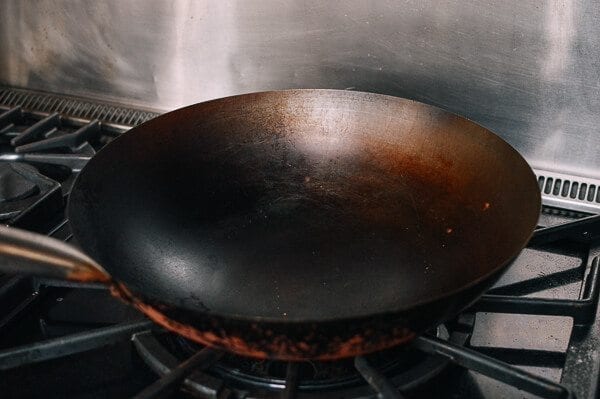
Sometimes a wok can rust on the bottom like this one pictured below. You can give the outside a good scrubbing to remove the surface rust and wipe it down with a few drops of oil on a paper towel.
Be sure to heat the wok to dry it thoroughly after each use to prevent further rusting.
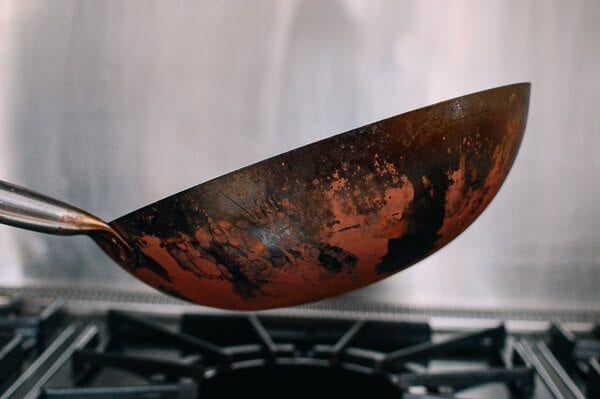
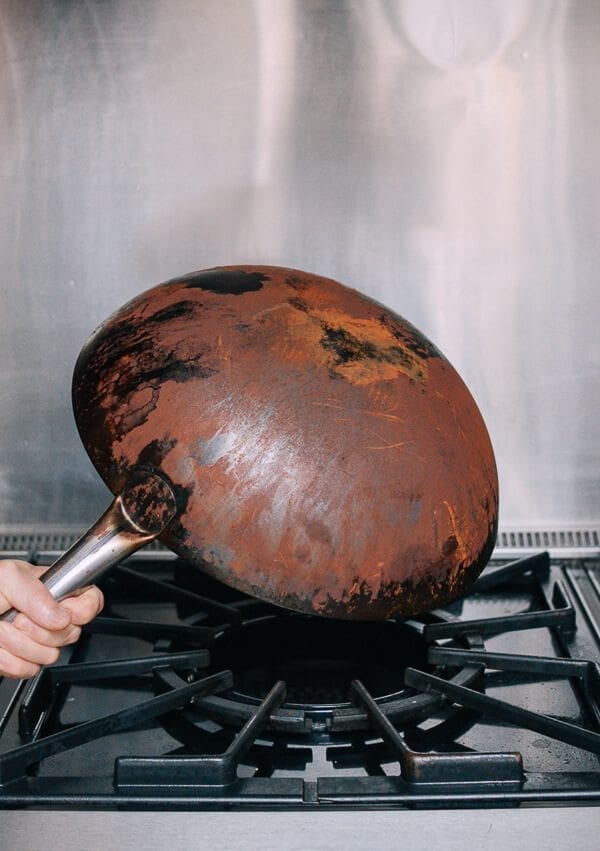
Regular wok care
After you’ve removed the food from the wok, wash it.
Some people think seasoning a wok means leaving the oil and film from your last meal, but that’s a common misconception. In general, for light cooking, scrub the wok with just water. For heavier oily residue, use dish soap as well.
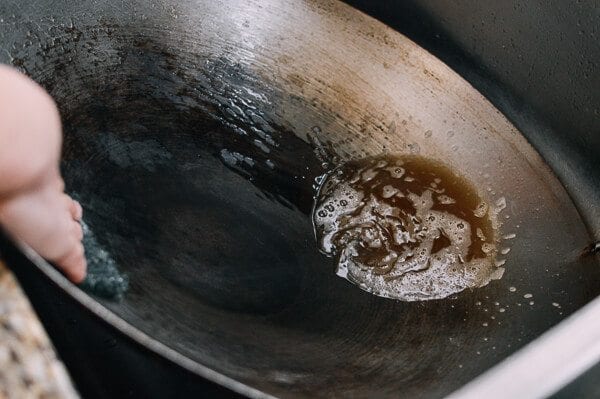
Use a circular scrubbing motion with a scouring pad.
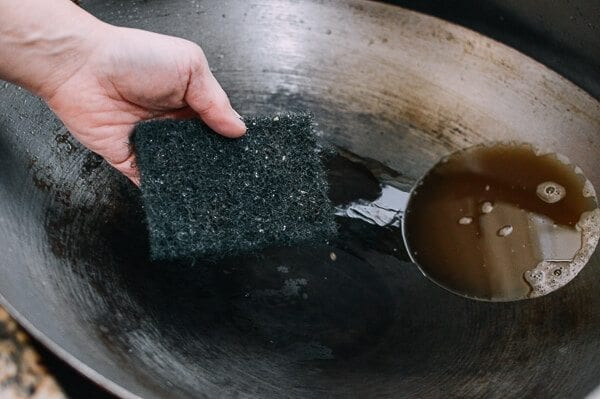
Clean it thoroughly! You don’t have to scrub it to death, but you do want to clean burnt and crusty bits and any excess oil just like you’d do with any other pan.
This is especially true after cooking dishes with heavy sauces, when some of the sauce may be crusted on.
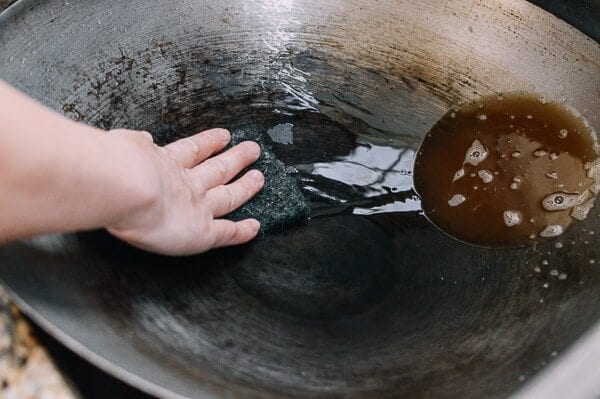
If needed, scrub the exterior of the wok with the scouring pad. It’s fine if the outside of the wok is a little rough.
Rinse the wok and dry thoroughly with a kitchen towel or paper towel. Place the wok back on the stove and heat until all the water has completely evaporated.
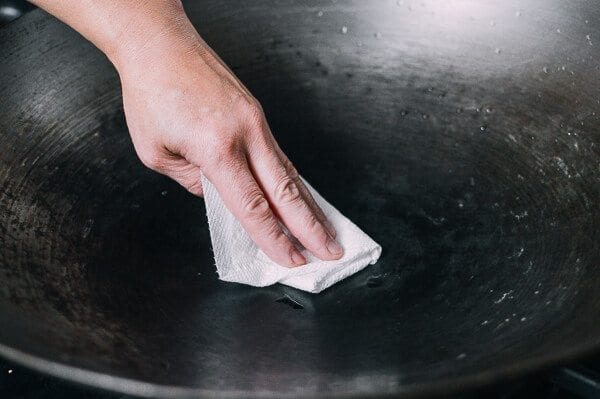
Let the wok cool and wipe the inside with a few drops of oil and a paper towel. Wipe the oil all over the wok to give the surface a light coating.
It’s perfectly normal to see some brown residue on the paper towel after this wipe-down.
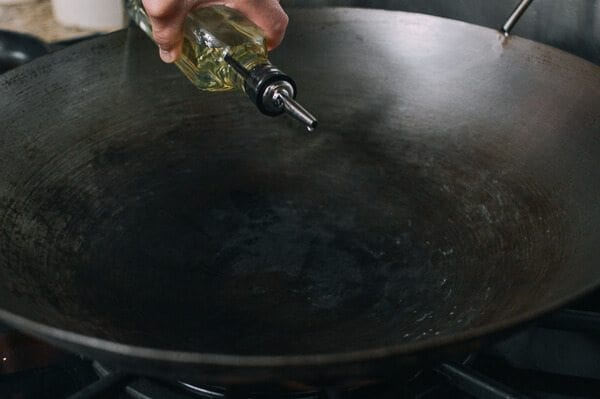
If you do see rust form the next time you use it, it is likely that it was not completely dried or you may not have used enough oil.
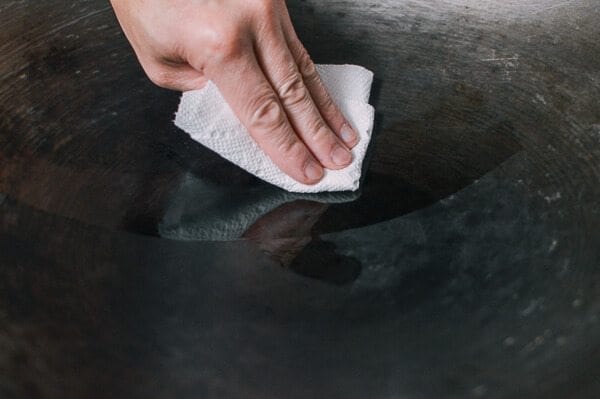
This is our large 20-inch (50cm) wok that we use on our range with the dedicated wok burner. We use this for steaming large dishes, cooking during holidays and parties, and when blogging, of course (lots of surface area for photographs)! You can see the beautiful shiny patina after using it almost every day for the past 12 years.
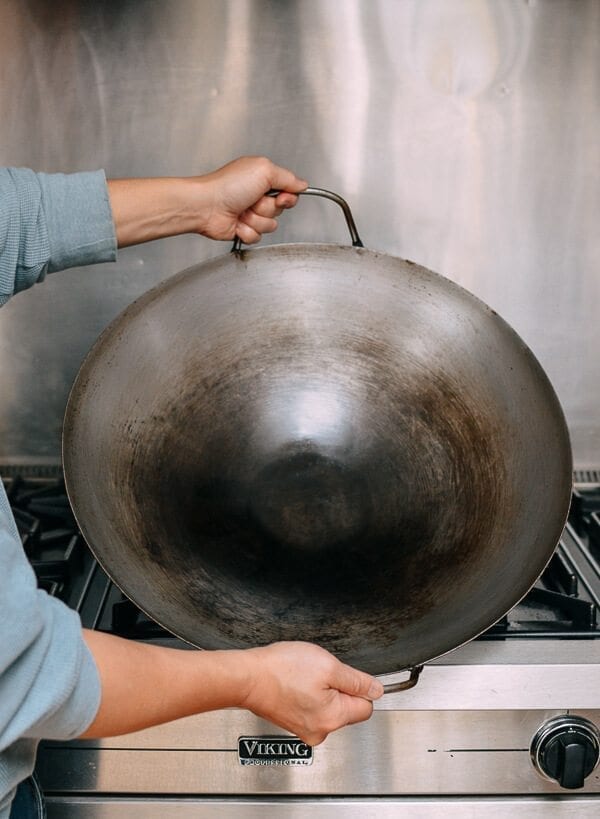
Tips for Maintaining a Seasoned Wok
- Always wash and dry your wok after cooking and wipe it down with vegetable oil, even after a simple steaming.
- If you find the wok has a rusty spot, then you probably did not heat it long enough to get rid of all the moisture or did not use enough oil to wipe it down. Pay attention to these two important steps!
- If you just cooked an especially strong food (e.g. a fish or a curry dish), you may have to wash and heat the wok twice. Heat helps rid the wok of residual flavors. It’s disappointing to cook a lightly seasoned dish only to taste the fish you cooked last night.
- If you haven’t used the wok in a long time, you should wash it before using.
- Never put your wok in the dishwasher!
- After cooking with vinegar or any other acidic ingredient, promptly wash your wok. Any acid will wear away the patina of the wok. You can also use a stainless steel wok or a pot to cook hot and sour soup or dishes like our sweet and sour pork or Peking ribs.
- If you see buildup or if your wok is looking worse for wear, you can follow the steps for a new wok above to re-season it anytime.
How to Season a Wok
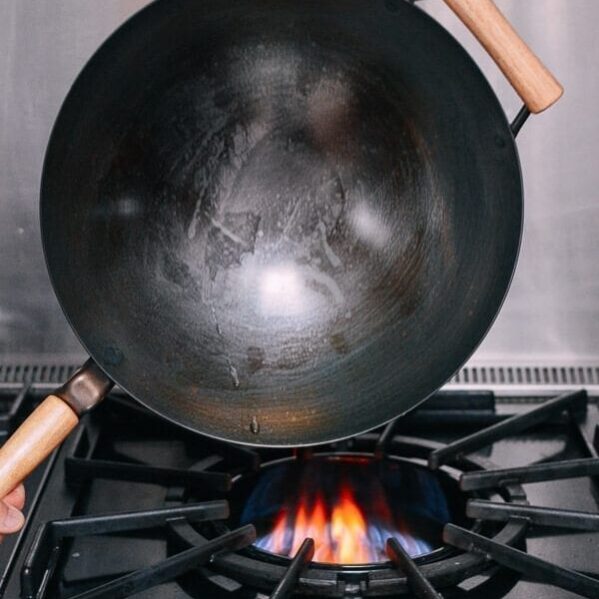
Ingredients
- carbon steel wok
- heavy duty aluminum foil
- gas stove or outside burner (gas is best, though you can also do this on an electric stove)
- oven mitt or dry kitchen towel
- scrub sponge or scouring pad
- paper towel (for wiping oil onto the wok)
- 1 tablespoon vegetable oil
Instructions
- If your wok has wooden handles, wrap them in heavy duty aluminum foil to prevent them from burning.
- Set your wok on your stove set to the highest heat. Make sure you clear the stove area, because things will get quite hot. Keep a dry kitchen towel handy or better yet, a silicon/heatproof kitchen mitt in case the wok handles get too hot.
- Once the wok heats up, it will start turning a dark brown color and begin to smoke. This indicates that the residual oils from the wok are burning off. Next, the wok will begin superheating and the impurities from those industrial oils will burn off. Tilt the wok to superheat one area at a time, until the entire wok surface has taken on a blue tint.
- Turn off the burner and set the wok back on the stove to cool for a few minutes. Carefully pour about 1 cup of hot water into the wok to cool it off.
- When your wok is completely cooled, move it to your sink and give it a light scrubbing (you can use a small amount of dish soap). Rinse your wok thoroughly with clean water. You may see some dark spots in the metal from impurities in the carbon steel, but this is nothing to worry about.
- Wipe down the excess water with a paper towel and place the wok back on the burner to dry it over medium high heat.
- After the wok is thoroughly dried, add about a tablespoon of vegetable oil to the wok over low heat. Spread the oil around the wok by tilting it until you get an even coating. Turn off the heat and use a twice-folded paper towel to begin wiping down the wok. Use your wok spatula to start since the wok will be hot.
- Repeat this wash/dry process one more time (and each time you use your wok) and your new carbon steel wok is ready for cooking your favorite dishes!
